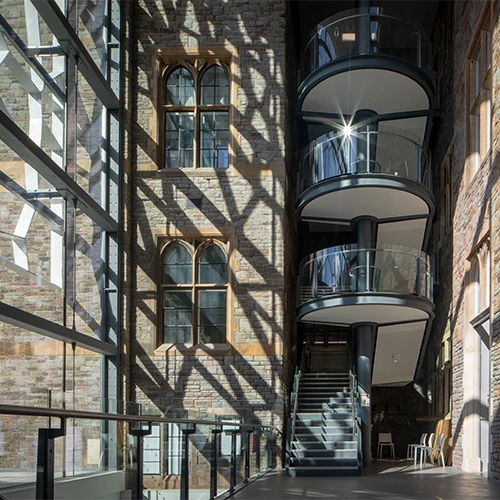WIA | Runder Tisch: Tageslicht, Nachhaltigkeit und Wellbeing

***English version below***
Runder Tisch: Tageslicht, Nachhaltigkeit und Wellbeing | Dialog | Women in Architecture 2021
Am 21.06.21 von 19:15 Uhr bis 20:45 Uhr in feldfünf und online
Klimawandel, Pandemie, Home Office, das neue Normal… Die Welt ist im Umbruch, und das macht nochmal deutlich wie wichtig der Einfluss von Tageslicht auf unser Leben und Wohlbefinden ist. Als Planerinnen, die direkt Einfluss auf den späteren Nutzerkomfort und die Gesundheit haben, ist Tageslicht ein zentrales Thema in unserem Alltag. Ein Thema, das vor allem bei den Normen auf Schwierigkeiten stößt und die Anwendung in der Planung erschwert.
Für uns ist es wichtig, das Tagelicht in jeder Phase des Projekts, vom Wettbewerb bis zur Realisierung, zu berücksichtigen und einzuplanen.
Die Fassadeningenieurin steht zwischen den Fronten, die Fassade muss genug Tageslicht hereinlassen, große Fenster haben, aber keine direkte Sonne hineinlassen, damit die Wärmegewinne nicht zu groß werden und die Sonne nicht blendet. Die Scheiben sollen nicht zu dunkel werden, sonst kommt nicht genug Tageslicht in das Gebäude. Was gibt es für Lösungen, die alle glücklich machen?
Die Lichtplanerin steht vor einem Spagat zwischen dem menschlichen Bedürfnis, Tageslicht im Gebäude zu haben – sowohl diffuses Himmelslicht als auch direktes Sonnenlicht und vor allem in großen Mengen – und den durch verschiedene Zertifizierungen vorgeschriebenen energetischen Zielen des Gebäudes. Entscheidend für das Tageslicht in der Architektur ist die Baumasse und Geometrie sowie die Ausrichtung und Lage des Gebäudes im Stadtraum.
Bauphysiker stehen oft vor dem Dilemma, dass hohe Transparenz gleichbedeutend mit hohen Wärmegewinnen im Sommer ist. Sie wünschen sich eine intelligentere Anwendung von Tageslichtprinzipien, um das Tageslicht zu den Menschen zu bringen, ohne dass eine Klimatisierung des Gebäudes notwendig ist. Ganz zu schweigen davon, dass die Nutzung von Tageslicht ein oft ungenutztes Potenzial zur Reduzierung des Stromverbrauchs für künstliche Beleuchtung bietet.
Tageslicht soll ein Grundstein für nachhaltiges Bauen sein, und das schon zu Beginn des Entwurfsprozesses.
Heute möchten wir einen Einblick in unseren Planungsprozesse geben und über den Weg, den wir gefunden haben, um zusammen eine integrierte Planung zu erstellen, sprechen. Unser Ziel ist, dass die Nutzung und der Umgang mit Tageslicht in den Vordergrund der Planung rückt.
Vor dieser Veranstaltung findet bereits ein „generationsübergreifender Talk für Architekt:innen“ mit TSSB architekten.ingenieure statt.
mit: Buro Happold und Paula Longato
Aufgrund der Pandemie können leider nur begrenzt Personen Vor-Ort sein.
Bitte melden Sie sich via Eventbrite an: > EVENTBRITE
Oder sind Sie online dabei. Es bedarf keiner Anmeldung!
Bitte folgen Sie über Ihren Browser diesem Link: > WIA Berlin YOUTUBE channel
Mit ihrer Teilnahme stimmen Sie der Aufzeichnung der Veranstaltung zu. Diese bleibt nachfolgend als Video auf dem WiA YouTube Kanal verfügbar.
© BuroHappold
***English version***
Roundtable: Daylighting, Sustainability and Wellbeing | Dialogue | Women in Architecture 2021
On 21 June, 2021 from 7:15 pm to 8:45 pm at feldfünf and online.
Climate change, pandemic, home office, the new normal... The world is changing, and this again highlights the importance of the impact of daylight on our lives and well-being. As planners who have a direct impact on subsequent user comfort and health, daylight is a key issue in our everyday lives. It is a topic that encounters difficulties, especially when it comes to standards, making it difficult to apply in planning.
For us, it is important to consider and plan for daylighting in every phase of the project, from the competition to the realization.
The façade engineer stands between the fronts, the façade must let in enough daylight, have large windows, but not let in direct sun, so that the heat gains are not too great and the sun does not dazzle. The windows should not be too dark, otherwise not enough daylight will come into the building. What solutions are there that will make everyone happy?
The lighting designer faces a balancing act between the human need to have daylight in the building - both diffuse sky light and direct sunlight, and especially in large amounts - and the building's energy goals mandated by various certifications. Critical to daylighting in architecture is the building's mass and geometry, as well as its orientation and location in the urban environment.
Building physicists often face the dilemma that high transparency equals high heat gain in summer. They would like to see a more intelligent application of daylighting principles to bring daylight to people without the need to air condition the building. Not to mention that the use of daylighting offers an often untapped potential for reducing electricity consumption for artificial lighting.
Daylighting should be a cornerstone of sustainable building, starting at the beginning of the design process.
Today, we'd like to share some insight into our design process and talk about the way we've found to work together to create an integrated design. Our goal is to have the use and treatment of daylight come to the forefront of the planning process.
This event will be preceded by an "intergenerational talk for architect:ing" with TSSB architekten.ingenieure.
with: Buro Happold and Paula Longato
Unfortunately, due to the pandemic, only a limited number of people can be on-site.
Please register via Eventbrite: > EVENTBRITE
Or join us online. There is no need to register!
Please follow this link via your browser: > WIA Berlin YOUTUBE channel
With your participation you agree to the recording of the event. This will remain available as a video on the WiA YouTube channel.
© BuroHappold